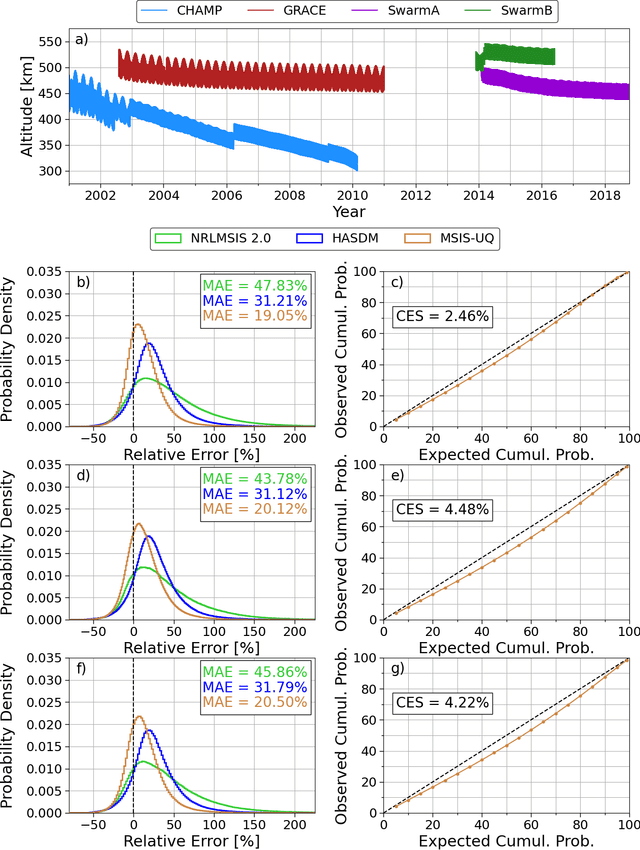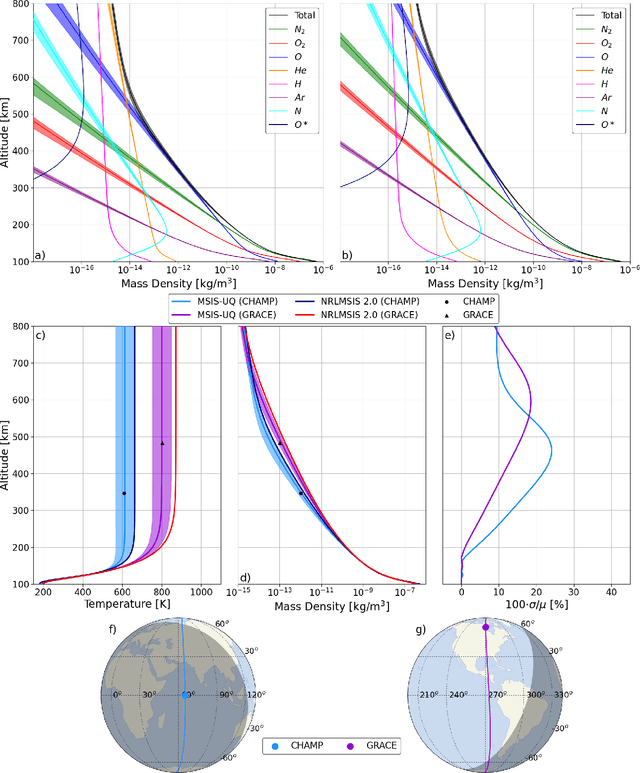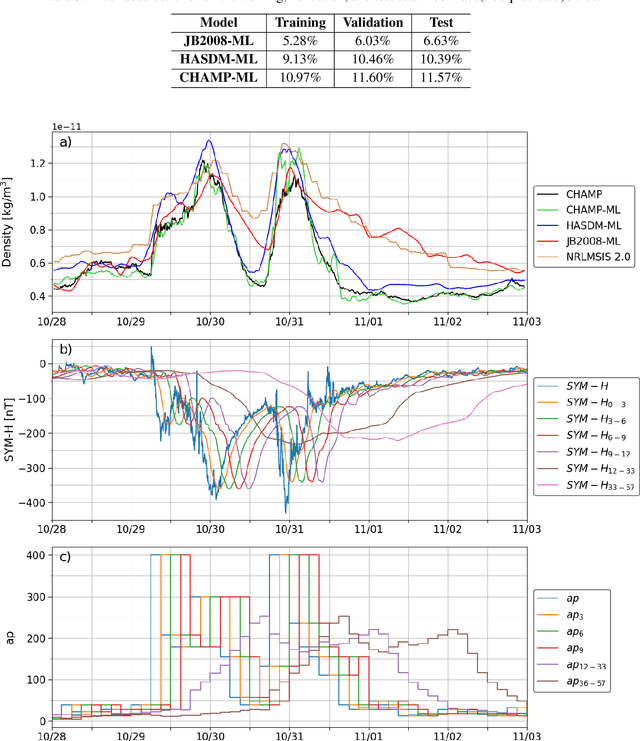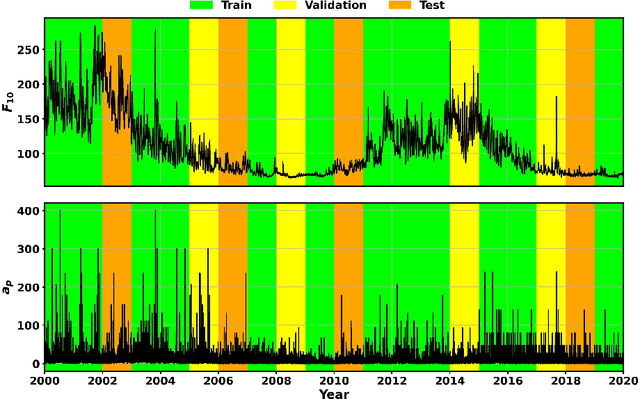Richard J. Licata
Reduced Order Probabilistic Emulation for Physics-Based Thermosphere Models
Nov 09, 2022Abstract:The geospace environment is volatile and highly driven. Space weather has effects on Earth's magnetosphere that cause a dynamic and enigmatic response in the thermosphere, particularly on the evolution of neutral mass density. Many models exist that use space weather drivers to produce a density response, but these models are typically computationally expensive or inaccurate for certain space weather conditions. In response, this work aims to employ a probabilistic machine learning (ML) method to create an efficient surrogate for the Thermosphere Ionosphere Electrodynamics General Circulation Model (TIE-GCM), a physics-based thermosphere model. Our method leverages principal component analysis to reduce the dimensionality of TIE-GCM and recurrent neural networks to model the dynamic behavior of the thermosphere much quicker than the numerical model. The newly developed reduced order probabilistic emulator (ROPE) uses Long-Short Term Memory neural networks to perform time-series forecasting in the reduced state and provide distributions for future density. We show that across the available data, TIE-GCM ROPE has similar error to previous linear approaches while improving storm-time modeling. We also conduct a satellite propagation study for the significant November 2003 storm which shows that TIE-GCM ROPE can capture the position resulting from TIE-GCM density with < 5 km bias. Simultaneously, linear approaches provide point estimates that can result in biases of 7 - 18 km.
Calibrated and Enhanced NRLMSIS 2.0 Model with Uncertainty Quantification
Aug 24, 2022



Abstract:The Mass Spectrometer and Incoherent Scatter radar (MSIS) model family has been developed and improved since the early 1970's. The most recent version of MSIS is the Naval Research Laboratory (NRL) MSIS 2.0 empirical atmospheric model. NRLMSIS 2.0 provides species density, mass density, and temperature estimates as function of location and space weather conditions. MSIS models have long been a popular choice of atmosphere model in the research and operations community alike, but - like many models - does not provide uncertainty estimates. In this work, we develop an exospheric temperature model based in machine learning (ML) that can be used with NRLMSIS 2.0 to calibrate it relative to high-fidelity satellite density estimates. Instead of providing point estimates, our model (called MSIS-UQ) outputs a distribution which is assessed using a metric called the calibration error score. We show that MSIS-UQ debiases NRLMSIS 2.0 resulting in reduced differences between model and satellite density of 25% and is 11% closer to satellite density than the Space Force's High Accuracy Satellite Drag Model. We also show the model's uncertainty estimation capabilities by generating altitude profiles for species density, mass density, and temperature. This explicitly demonstrates how exospheric temperature probabilities affect density and temperature profiles within NRLMSIS 2.0. Another study displays improved post-storm overcooling capabilities relative to NRLMSIS 2.0 alone, enhancing the phenomena that it can capture.
Science through Machine Learning: Quantification of Poststorm Thermospheric Cooling
Jun 12, 2022



Abstract:Machine learning (ML) is often viewed as a black-box regression technique that is unable to provide considerable scientific insight. ML models are universal function approximators and - if used correctly - can provide scientific information related to the ground-truth dataset used for fitting. A benefit to ML over parametric models is that there are no predefined basis functions limiting the phenomena that can be modeled. In this work, we develop ML models on three datasets: the Space Environment Technologies (SET) High Accuracy Satellite Drag Model (HASDM) density database, a spatiotemporally matched dataset of outputs from the Jacchia-Bowman 2008 Empirical Thermospheric Density Model (JB2008), and an accelerometer-derived density dataset from CHAllenging Minisatellite Payload (CHAMP). These ML models are compared to the Naval Research Laboratory Mass Spectrometer and Incoherent Scatter radar (NRLMSIS 2.0) model to study the presence of post-storm cooling in the middle-thermosphere. We find that both NRLMSIS 2.0 and JB2008-ML do not account for post-storm cooling and consequently perform poorly in periods following strong geomagnetic storms (e.g. the 2003 Halloween storms). Conversely, HASDM-ML and CHAMP-ML do show evidence of post-storm cooling indicating that this phenomenon is present in the original datasets. Results show that density reductions up to 40% can occur 1--3 days post-storm depending on location and the strength of the storm.
Uncertainty Quantification Techniques for Space Weather Modeling: Thermospheric Density Application
Jan 06, 2022



Abstract:Machine learning (ML) has often been applied to space weather (SW) problems in recent years. SW originates from solar perturbations and is comprised of the resulting complex variations they cause within the systems between the Sun and Earth. These systems are tightly coupled and not well understood. This creates a need for skillful models with knowledge about the confidence of their predictions. One example of such a dynamical system is the thermosphere, the neutral region of Earth's upper atmosphere. Our inability to forecast it has severe repercussions in the context of satellite drag and collision avoidance operations for objects in low Earth orbit. Even with (assumed) perfect driver forecasts, our incomplete knowledge of the system results in often inaccurate neutral mass density predictions. Continuing efforts are being made to improve model accuracy, but density models rarely provide estimates of uncertainty. In this work, we propose two techniques to develop nonlinear ML models to predict thermospheric density while providing calibrated uncertainty estimates: Monte Carlo (MC) dropout and direct prediction of the probability distribution, both using the negative logarithm of predictive density (NLPD) loss function. We show the performance for models trained on local and global datasets. This shows that NLPD provides similar results for both techniques but the direct probability method has a much lower computational cost. For the global model regressed on the SET HASDM density database, we achieve errors of 11% on independent test data with well-calibrated uncertainty estimates. Using an in-situ CHAMP density dataset, both techniques provide test error on the order of 13%. The CHAMP models (on independent data) are within 2% of perfect calibration for all prediction intervals tested. This model can also be used to obtain global predictions with uncertainties at a given epoch.
Machine-Learned HASDM Model with Uncertainty Quantification
Sep 16, 2021



Abstract:The first thermospheric neutral mass density model with robust and reliable uncertainty estimates is developed based on the SET HASDM density database. This database, created by Space Environment Technologies (SET), contains 20 years of outputs from the U.S. Space Force's High Accuracy Satellite Drag Model (HASDM), which represents the state-of-the-art for density and drag modeling. We utilize principal component analysis (PCA) for dimensionality reduction, creating the coefficients upon which nonlinear machine-learned (ML) regression models are trained. These models use three unique loss functions: mean square error (MSE), negative logarithm of predictive density (NLPD), and continuous ranked probability score (CRPS). Three input sets are also tested, showing improved performance when introducing time histories for geomagnetic indices. These models leverage Monte Carlo (MC) dropout to provide uncertainty estimates, and the use of the NLPD loss function results in well-calibrated uncertainty estimates without sacrificing model accuracy (<10% mean absolute error). By comparing the best HASDM-ML model to the HASDM database along satellite orbits, we found that the model provides robust and reliable uncertainties in the density space over all space weather conditions. A storm-time comparison shows that HASDM-ML also supplies meaningful uncertainty measurements during extreme events.
 Add to Chrome
Add to Chrome Add to Firefox
Add to Firefox Add to Edge
Add to Edge